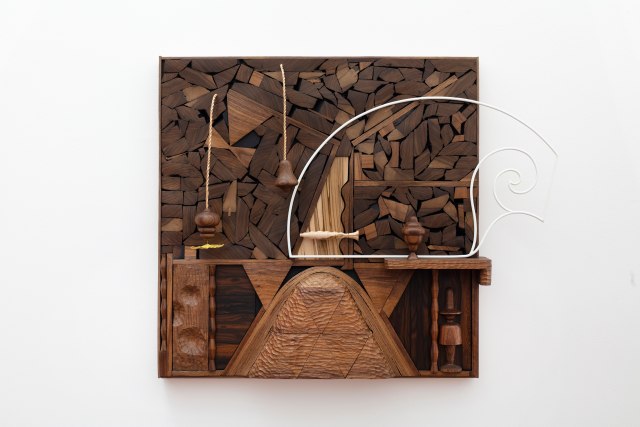CARBON 12 is pleased to present the works of André Butzer, Anthony Olubunmi Akinbola, Gil Heitor Cortesão, Edgar Orlaineta, Sarah Almehairi, Michael Sailstorfer and Bernhard Buhmann, each reflecting the gallery’s contemporary program and representative of the artists' current practices. The artworks bring focus towards the artists’ dynamic material play and conceptual approaches.
Anthony Olubunmi Akinbola’s (b. 1991, USA) intrinsic Durag paintings take the material’s cultural significance and value and distinguishes their purpose and use as unique to African American identity. Akinbola’s artistic practice approaches these readymade objects in a conceptual and investigative manner. He explores how these materials can translate and relay messages on race, consumerism, and fetishization in a contemporary setting.
While his works are deeply inspired by the utopian vision of 1960s and 70s architecture, as is referenced from images, postcards, and books the artist has collected over the years, Gil Heitor Cortesāo (b. 1967, Portugal) brings in a new perspective and aura of familiarity to his compositions. In these once futuristic then retro now ruined environments, the viewer still tends to feel like on outsider – an observer that is not allowed into these spaces but only permitted to witness the ongoings from the exterior, or even the interior.
André Butzer (b. 1973, Germany) is a colorist by nature. His playful and imaginative approach to painting fuses European Expressionism with American popular culture. Butzer has developed a unique and elaborate fictitious universe in which he explores the definitive nature of abstract- figurative painting. This new work, depicting Friedens-Siemens-children, as Butzer calls them, returns to earlier motifs the artist has explored. These round, smiley, and comically large shapes emerge from brightly colored backgrounds. In this rendition, a blocked background composed of five contrasting colors: red, yellow, purple, orange, and what can be described as a bronze brown.
Edgar Orlaineta (b. 1972, Mexico) focuses on hybrid sculptural forms that draw inspiration from modernism, popular culture, and specific historic moments. The works primarily explore post-war design and architecture depicted as biomorphic shapes owing to strong surrealist influence. Either by incorporating craft elements or combing them into assemblages with everyday objects that lack any historical relevance in his interventions and assemblages, Orlaineta seeks to open these design objects to new perspectives through denial of their functionality and value to reactivate the legacy of the historical avant-garde.
Michael Sailstorfer’s (b. 1979, Germany) I can hear you #8 is composed entirely of salt. Exploring sentience and transformation in both material and conceptual contexts, the artist’s material exploration is integral to his practice. When exposed to the elements, the salt undergoes a transformational process and disintegrates. The erosion process alludes to the very transience of nature and harkens back to the essence of it all - to draw in a breath of air and let go of it.
Bernhard Buhmann’s (b. 1979, Austria) compositions walk a fine line between abstraction and figuration as his chromatically rich compositions recall historical tradition and the contemporary condition to question identity construction. The vector-like abstractions unfold multiple hues and gradients that translate into the affective impact of data as it continues to transform the beliefs and perceptions of people today.
Sarah Almehairi’s (b. 1998, UAE) delicate and meticulous works are a direct physical translation of her intimate and ephemeral interaction with the ground as its own ecosystem - a way for the artist to build on a specific narrative with her surroundings. Examining the construction of systems
through their deconstruction, Almehairi’s collage works emphasize the compositional characteristics of intuitive layering and building.
Continuously pushing the boundaries of their chosen materials, the artists touch on themes of hybridity, construction and deconstruction, fictitious environments, culture, history, and geographic contexts.






